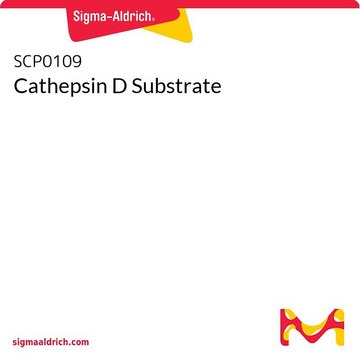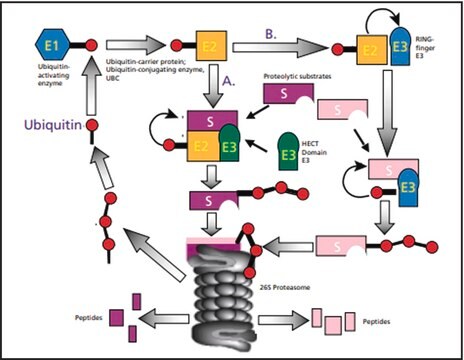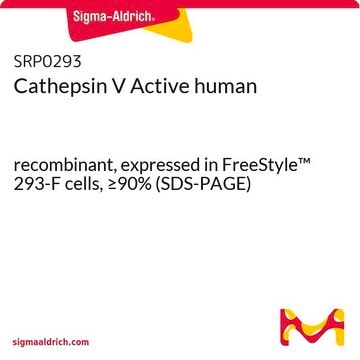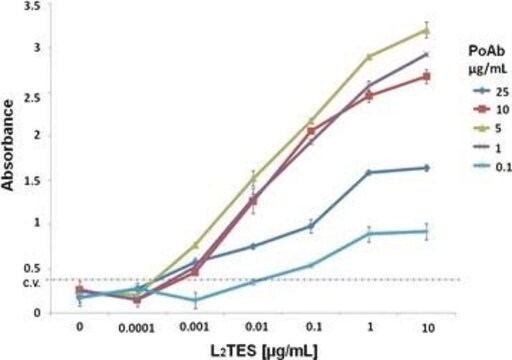推薦產品
生物源
human
重組細胞
expressed in HEK 293 cells
籤條
6-His tagged (C-terminus)
化驗
≥95% (SDS-PAGE)
形狀
lyophilized
分子量
calculated mol wt 43.6 kDa
observed mol wt 45-55 kDa (DTT-reduced. Protein migrates due to glycosylation. Ser 19 is the predicted N-terminal.)
包裝
pkg of 10 μg
製造商/商標名
Sigma-Aldrich
儲存條件
dry at room temperature
技術
activity assay: suitable
雜質
<1 EU/μg endotoxin (LAL test)
適合性
suitable for molecular biology
UniProt登錄號
應用
life science and biopharma
運輸包裝
wet ice
儲存溫度
−20°C
基因資訊
human ... CTSD(1509)
一般說明
Research area: Cell signalling. Cathepsin D belongs to the peptidase A1 family, an estrogenic-induced lysosomal protease. Cathepsin D can be cleaved into the following 2 chains: N-terminal light chain and C-terminal heavy chain, which is expressed in the aorta extracellular space (at the protein level). ). It is found in most mammalian cells and is located in thelysosomes.
This gene is mapped to human chromosome 11p15.5.
應用
Cathepsin D has been used in the protease digestion of haemoglobin.
生化/生理作用
Cathepsin D (CatD) takes part in the intracellular degradation of advanced glycation end (AGE) products. AGE deposition is predominant in photoaged skin. Thus, CatD might be useful in antiphotoaging therapy. Elevated circulating CatD is observed in type 2 diabetes and can be considered an important biomarker for type 2 diabetes-dependent cardiac dysfunction. Increased CatD, is observed in non-alcoholic steatohepatitis.Cathepsin D is involved in various physiological processes like apoptosis, autophagy, and protein degradation. Cathepsin D plays an important role in the pathogenesis of Alzheimer’s disease, neuronal ceroid lipofuscinosis, and breast cancer.
外觀
Lyophilized from 0.22 μm filtered solution in 50 mM MES, pH 6.5 with 100 mM NaCl. Generally 5-8% Mannitol or trehalose is added as a protectant before lyophilization.
重構
Centrifuge the vial prior to opening. Reconstitute in sterile PBS, pH 7.4 to a concentration of 50 μg/mL. Do not vortex. This solution can be stored at 2-8°C for up to 1 month. For extended storage, it is recommended to store at -20°C.
儲存類別代碼
11 - Combustible Solids
水污染物質分類(WGK)
WGK 3
閃點(°F)
Not applicable
閃點(°C)
Not applicable
Plasma cathepsin D correlates with histological classifications of fatty liver disease in adults and responds to intervention
Walenbergh SMA, et al.
Scientific reports, 6(1), 38278-38278 (2016)
Cluster analysis of risk factor genetic polymorphisms in Alzheimer?s disease
Randall CN, et al.
Neurochemical Research, 34(1), 23-28 (2009)
Increased Cathepsin D Correlates with Clinical Parameters in Newly Diagnosed Type 2 Diabetes
Liu L, et al.
Disease Markers, 2017(1), 23-28 (2017)
Xiaolai Zhou et al.
Molecular neurodegeneration, 12(1), 62-62 (2017-08-25)
Mutations resulting in progranulin (PGRN) haploinsufficiency cause frontotemporal lobar degeneration with TDP-43-positive inclusions (FTLD-TDP), a devastating neurodegenerative disease. PGRN is localized to the lysosome and important for proper lysosome function. However, the metabolism of PGRN in the lysosome is still
Cathepsin D contributes to the accumulation of advanced glycation end products during photoaging
Xu X, et al.
Journal of Dermatological Science, 90(3), 263-275 (2018)
我們的科學家團隊在所有研究領域都有豐富的經驗,包括生命科學、材料科學、化學合成、色譜、分析等.
聯絡技術服務








